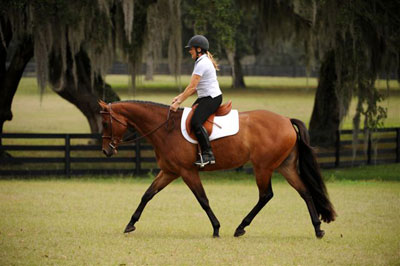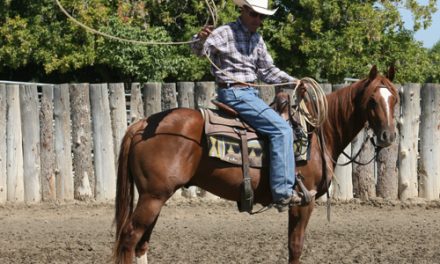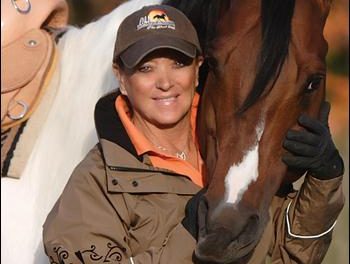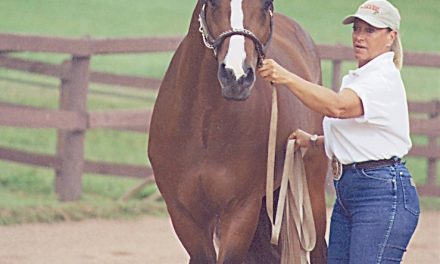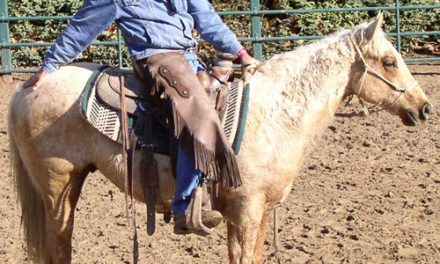Palm Partnership Training
 You’ve probably already figured out that you can do the same dressage maneuvers in a Western saddle that you can do in a “regular” dressage saddle. This reminds me of our Western Dressage motto, “Why Not?!” I’ve been saying that since I learned of the vast interests in Western Dressage at the 2010 FEI World Equestrian Games.
You’ve probably already figured out that you can do the same dressage maneuvers in a Western saddle that you can do in a “regular” dressage saddle. This reminds me of our Western Dressage motto, “Why Not?!” I’ve been saying that since I learned of the vast interests in Western Dressage at the 2010 FEI World Equestrian Games.
For the first 30 years of riding, I rode consistently in the dressage saddle. I still find myself training the exact same way whether I am in a Western saddle or a dressage saddle. Dressage principles are the basis of my show ring success. By using these principles with the training of the horses, I find I ride the same when riding in a hunt seat or Western saddle.
I would guarantee you if you put a western saddle—correctly fitted, of
course—on a Gran Prix horse and started to do Piaffe, Tempi changes, Passage, Half
Pass, etc., you would find that a horse can do just as well in a Western saddle! It does not
matter to a horse what saddle is on his back, unless it does not fit the horse or rider
correctly. Actually, I find the dressage and Western saddles are the most similar. You
ride in a sitting position at the walk, trot, and canter in a dressage saddle. If you are riding
correctly in a Western saddle, you mirror the same basic principles at the walk, jog and
lope. You can post to the trot in the Western or English saddle too.
Have you ever compared dressage and Western riders? I encourage you to do this
using my latest book, “A Riders Guide To Real Collection.” If you use another book, just
make sure it features good quality training and correct horsemanship. Now, compare
photos of riders. You are going to find the English riders and the Western riders are in similar positions. You should be able to define a vertical straight line from their ear, shoulder, middle of the hip, back of the heel to the ground. This vertical alignment that we must maintain while riding the horse in his three gaits is so similar, no matter what saddle you are using. For example, the Western rider can ride with two hands just like the English rider. This is a similar balanced position. Remember, the horse does not care about the saddle as long as it fits properly.
Whether you are riding in a dressage or Western saddle, the universal aids of
seat, legs and hands used to communicate with the horse are all the same. It should not
matter what saddle you are in, as long as you are consistently using your aids correctly. If
you had a big, bulky, thick leathered Western saddle, you may not be able to use your
aids as “close contact” as a dressage saddle. My Western dressage saddle gives just as
close contact with my horse as my dressage saddle. I just love it!
The training of the horse and the levels you follow to improve the horse’s knowledge and performance, as well as your own skills, does not depend on the saddle you ride. The saddle is just a tool to keep you in balance with your horse, feel the horse underneath you, and to give your horse comfort as he carries your weight. A horse should have no problems unless the saddle does not fit.
I find that most riders love the Western saddle because it has a bigger seat and a horn for confidence. A Western saddle does not challenge your balance as much as an English dressage saddle does. All English saddles require more balance from the rider and a skill level, so they don’t rely on the horn if they should need it for balance. We require all our Western riders to ride English simply because I believe that riding English (dressage or hunt seat) will improve your Western riding. Over the years, this has proven very true.
I would like to end this training article with a challenge for you. If you have a friend or student who rides only Western, try to get them in an English saddle. They will find it helps their Western riding by enhancing balance and confidence. If you know an English rider, try to get them to ride in the Western saddle. They will have a blast, as it is so much more comfortable if the saddle is of top quality. Most riders retire riding in a Western saddle! Don’t ever forget that!
We love to share our dressage backgrounds and knowledge with you and would love to have you come ride with us. You can join us at our farm in Ocala, Florida, or at one of our Ride Well Clinics on our USA Tour at a location near you.
If you would like to train with Lynn & Cyril at home with Western Dressage, take advantage of the following supportive training materials:
Books:
Head To Toe Horsemanship
Western Dressage—A Guide to Take You to Your First Show
A Rider Guide to Real Collection
DVDs:
“Dressage Principles for the Western Horse & Rider” Volume 1 Parts 1-5
“Dressage Principles for the Western & English Horse & Rider” Volume 2,Parts 1-3
“Let Your Horse Be Your Teacher” Parts 1&2
For more information on these training materials and more, as well as clinics, please
visit Lynn Palm or call us at 800-503-2824.

